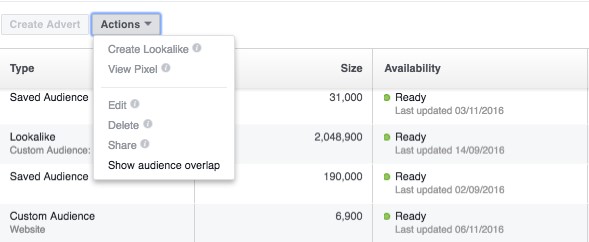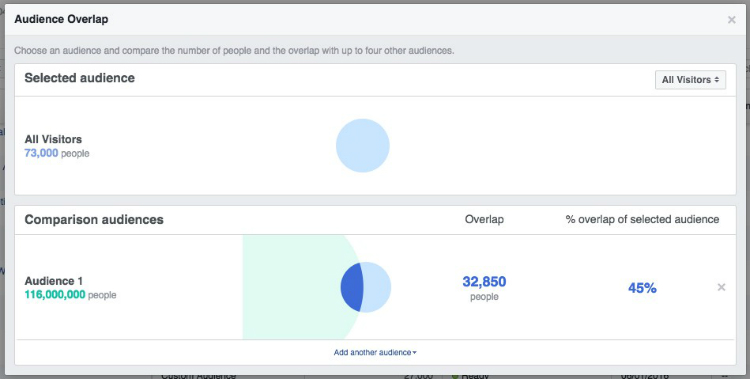Facebook Marketing and Audience Overlap
A successful marketing campaign involves a lot of challenges. Facebook marketing is no exception. The challenging factors keep adding up as you progress. But what’s the fun when you don’t have challenges in your online marketing strategies? One such factor is the “Audience Overlap” in Facebook marketing.
What is Audience Overlap in Facebook Marketing?
You get a lot of chances to play around with different sets of audiences for promotions and engagements. But the intriguing part that lies behind that is that there could be same folks within different audience sets.
Now, this leads to audience overlap issue. Meaning, you end up showing ads to the same user, which in turn affects your campaign’s performance. We’ll get to see that in a while and how it actually happens. Before getting into that, let us understand the audience overlap even better.
By Jan 2016, Facebook enabled the audience overlap tool for its users. This is absolutely a powerful tool for Facebook marketers to understand the overlap amongst different sets of audiences they run the campaign for. Depending on the results, they can strategize the campaigns in a better way.
Audience overlap did have a serious impact on the campaigns of several expert marketers. It is not that they were unable to see through this, but Facebook did not provide an explicit tool to understand the audience overlap segments. As an impactful factor, the campaigns took a set back and started delivering poor results. One good option to identify was the ad frequency metric. Though it was not a direct metric to understand the audience overlap, it helped the marketers understand that they were showing the ads to the same folks. Higher the number, lower the performance.
Though it was not a direct metric to understand the audience overlap, it helped the marketers understand that they were showing the ads to the same folks. Higher the number, lower the performance.
How to use the Ad Frequency Metric to understand Facebook Marketing Audience OverlapClick To TweetTo have a clear understanding over the audience overlap, let’s consider an example. You run different campaigns for promoting your business. The first one is the audience set of your Facebook business page followers. The second one shall be your website visitors. And the third one could be your lookalike audience of your customers.
Now, there are chances that same folks could be available on all the three sets. Once this scenario happens, the same advertisement might be shown to the same guy again and again. This increases the ad frequency and the campaign conversions might take a noticeable setback.
The Facebook Audience Overlap Tool:
Now, let’s move on to the tool and understand your audience better. You can find the audience overlap tool under your audience category. For accessing this tool, you should choose a minimum of two audience sets. Once you’re done with selecting the audience sets for which you want to measure the overlap, now go to “Actions” and select “Audience Overlap”.
Once you perform this action, you’ll be able to see the overlapped numbers along with the graph. Now you’d be in a comfortable position to understand the level of overlap. Furthermore, you can work on your targeting options and tweak the campaigns to perform better.
Ah! The tool has got some limitations as well. Yes! You need a minimum of 1000 people in an audience set to understand the overlap. Apart from that, you can only run this tool for custom audience, lookalike audience, and the saved audience!
Saved Audience Vs Custom Audience
This will be an important comparison since overlap happens with high percentage under these audience sets. The scenario is quite simple. You might create a new audience by setting various criteria, their interest sets, their location and behaviors. You might also install Facebook’s conversion pixel and start building the audience bucket for your website visitors. There are maximum chances that same audience could be present in these two sets.
As a best practice, it is recommended to run the overlap test for these two audience sets and understand the overlapping percentage. If it is too high, it is quite necessary to work on the audience sets and run different campaigns for both. If you still proceed further by running same ad sets for both the audiences, you might end up losing a lot of engagement and conversions.
Saved Audience Vs Lookalike Audience
This is just going to be like the previous check. Particularly, you create a new audience with respect to your competitors. Let’s consider that you build this audience for the people who have shown interest in your competitor products, liked your competitor’s Facebook business page, engaged with your competitor’s posts and much more. You can also target them location wise and behavior wise as well. And simultaneously, you upload a customer list on your account and start building a new lookalike audience for it.
When the lookalike audience gets matured (has enough numbers), there are chances that it might overlap with your competitor’s audience set. It is better to understand the level of overlap and tweak the campaigns to yield better results.
Email List Vs Website Visitors
List building is never easy for any business. Once built, they should be handled with at most care. A lot of companies fail to understand this. They stand a good chance for a conversion at anytime! With the help of Facebook, showing ads for your email subscribers/lists has become dead easy. You just need to upload the list on to Facebook and create a new audience list. That’s it, your email list becomes an audience and is ready for your Facebook ad campaign.
Building website visitor audience through the help of Facebook pixel is easy too. But it’s quite common to fail to segment them. Yes! You read that right. ‘Website visitors’ is a generic term. You can segment your website visitors’ month-wise, page visit wise, product wise, pricing wise, and even category wise. If you take up the overlap check for Email list and website visitors as such, the rate would be absolutely high. Because the email list was built with the help of website visitors, it is recommended to check the overlap level by comparing weekly and monthly data.
A Key Factor in Facebook Marketing is to check Overlap by Comparing Weekly and Monthly Data.Click To TweetCustom Vs Custom
Of late, this has been happening across several companies. But it stands for a valid point, though. The custom audience versus custom audiences contributes to website visitors here. Let’s take a look at another example to better understand this situation. You have an audience bucket for your business website and collect the “features page visitors” in a separate bucket and “pricing page visitors” in another separate bucket.
You can target the Features page audience with the feature set related ads and the pricing page visitors audience with pricing offers ad sets. But we cannot guarantee that both the audiences will be unique. There could be people who might have visited the features page before heading onto the pricing page and you might end up showing them with both the ad sets.
This might still have a negative impact on the performance of the campaign. Through the help of Facebook Audience Overlap tool, you can understand how much they overlap and what can be done to improvise the campaign.
Lookalike Vs Lookalike
This is another classic example to experiment with. Let us consider that we have two separate audiences for our ad campaigns. They are website visitors and email list. We could try to expand our audience base by building a lookalike audience set with the help of the existing audience sets. We can then create two separate audience lists for both. It is not necessary that both the audiences that are newly built could be unique.
There are chances for high overlap rate between the two new set of audiences. If the overlap rate is above 60 to 70%, it is better to switch off either of the two. Though we might miss the potential conversions from the left out unique audience, we’d have saved the best ones from the other set. As you can see, the chances of campaign giving poor results are pretty high if you run the same ad campaign for both the audiences.
Apart from these strategies and combinations, marketers have numerous other examples and their way of analyzing the audience overlap. This tool has been absolute gold and phenomenal from Facebook. At least, Facebook has saved businesses from wasting huge amounts of money through the audience overlap factor with the help of this tool.
Now, it is your turn to share your insights and results of your experiments with the Facebook Audience Overlap tool. Please feel free to share your thoughts, comments, and insights in the comments section!








